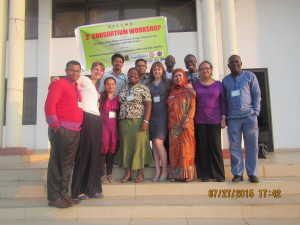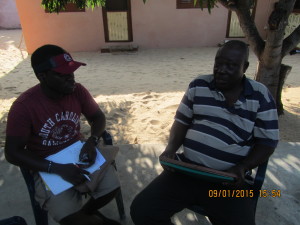I have been home in Ghana (full disclosure) since July, 2015 to carry out fieldwork for my dissertation and work on my research assistantship which is funding me for the next few years till I complete and defend my dissertation hopefully in May, 2017 (GOD let it be so!) For my research assistantship I am affiliated with the DECCMA project which seeks to assess vulnerability to climate change and migration and adaptation in 3 deltas in Ghana, India and Bangladesh. DECCMA is one of 4 consortium research projects under the Collaborative Adaptation Research Initiative in Africa and Asia (CARIAA) funded by IDRC and DFID. My specific activities with DECCMA are contributing to the activities of the Migration and Adaptation work packages.
Between July 24 and 28, 2015 I spent my time attending the 3rd Whole-Consortium Workshop of the DECCMA project at the University of Ghana, Legon. It was quite a steep learning curve for me the first few days in trying to come up to speed with a project I had only followed from afar. One thing that stood out to me in my furious note taking and incessant picture snapping was that there was a lot of talk of “keeping things consistent across the three deltas.” That bugged me-and it kind of still does. For one who is gung-ho about context-specific and localized interpretive research I just had mental images of layers of rich, high-resolution, nuanced and complex information being glossed over for consistency or comparability. The horror!
Don’t get me wrong at all. I totally understand the need for similarity in order to enable comparison. I needed to set such parameters in my own dissertation research (which I will talk about soon). But I am still plagued by the question of whether we should not be okay with even different research designs or approaches in different places if the ultimate goal of the research is to develop locally-appropriate or relevant policy recommendations and funding proposals (see the Aims tab if you bother to open the link).
Kwame with a cross-section of the Migration Work Page at the 3rd DECCMA Consortium Workshop
My own dissertation research, which seeks to evaluate the success or otherwise of sea defense systems (SDS) as an adaptation to climate change from the perspective of different stakeholders, currently has the presence of a SDS in a particular area of the Volta River Delta of Ghana as the singular variable to include any site in the comparative analysis. Even within one area (the Keta Municipality) I discovered the presence of two SDSes so now I am juggling whether to compare three as opposed to two. Why can’t the object of a delta be enough of a variable of similarity for large consortium-based comparative work such as DECCMA? Granted, in my own research I am borrowing from the LIG approach as research design and method-however even after only 1 full week of fieldwork I am realizing that I will need to tweak my questions based on this approach from person to person let alone between sites.
Kwame interviewing a Chief Fisherman in one of the communities along the Keta Sea Defense System
Please do not hear me damming the work of DECCMA. Far be it from me! I am so honored and proud to be part of such a large interdisciplinary and groundbreaking project. However I look forward to seeing, as I engage in my own research and contribute to that of DECCMA, how comparative research can still remain context specific and locally relevant yet not lose its validity of rigor in the eyes of the rest of the scientific community. I guess “rigor” depends on who is assessing – but that is a thought for another blog post.


